
Picking the right technology stack is one of those early, terrifying decisions. Get it right, and you're flying. Get it wrong, and you're tangled in technical debt before you've even found your first customer. This isn't just about code; it's a strategic choice that pits your immediate needs against your future dreams, directly impacting your development speed, scalability, and, let's be honest, how much this whole adventure is going to cost.
The best way to tackle this is to get brutally honest about what your project actually needs and what your team can realistically deliver with the skills and budget you have right now. Forget the hype for a moment. Let's get practical.
The Crossroads of Code and Strategy
Every great project starts with an idea, but the first real wall you hit is the paralyzing question: "What do we build this with?" It feels like a moment where one wrong turn could send you down a path of endless rewrites and frustration.
I once worked with a founder who was completely frozen at this stage. His team was split right down the middle. One camp was pushing for a shiny new framework that promised incredible performance and a modern developer experience. The other half argued for a battle tested, "boring" technology they already knew inside and out. It was a classic showdown between the exciting and the practical.
The Pressure to Pick Perfectly
The pressure was immense. He was terrified of getting locked into the "wrong" technology, a decision that could make hiring a nightmare or scaling impossible down the line. This fear is incredibly common, and it often leads to what we call decision paralysis, where you're so afraid of making the wrong choice that you end up making no choice at all.
And let's not forget the subtle temptation of "resume driven development." This is when engineers, consciously or not, advocate for technologies they want to learn rather than what the project actually needs. It's a real thing, and it can steer a project off course before it even starts. Spotting these kinds of internal risks early is crucial, something you can get better at by reviewing a comprehensive technical due diligence checklist.
The goal isn't to find some mythical "perfect" stack. The goal is to find the most practical stack that gives your team the shortest path to delivering value to users, today, while keeping the door open for tomorrow.
Reframing the Decision
Instead of seeing this as a single, make or break moment, you need to treat it as a strategic process. The right choice creates harmony between three core elements:
- Your Project's DNA: What problem does your application solve, and for whom?
- Your Team's Real World Skills: What technologies can your team use to be productive right now?
- Your Long Term Vision: Where do you see this product in two years? What about five?
Laying a solid foundation requires aligning your code with your strategy, and a deep dive into choosing a mobile app tech stack can offer invaluable perspective. Throughout this guide, we'll walk through a practical framework for balancing these factors, turning a moment of paralysis into a moment of strategic clarity.
Let Your Project's Needs Guide Your Choice
Before you get lost in framework debates on Twitter, the most important voice to listen to is your project's. It's painfully easy to get distracted by what's new and exciting, but a beautiful piece of technology solving the wrong problem is just expensive noise. The first step is to become an expert on the problem you are actually solving.
This means moving beyond generic advice and getting into the weeds of your specific technical requirements. Are you building a simple marketing site or a real time data processing engine? Does it need to handle a million concurrent users on day one, or will it serve a small, dedicated audience?
Answering these questions clarifies the architectural foundation you need. Think of it like this: you wouldn't use the same blueprint for a garden shed and a skyscraper. The same logic applies to software.
From Business Model to Tech Model
Different business models demand vastly different architectural choices. Let's contrast a few common scenarios to see how this plays out in the real world.
- B2B SaaS Platform: Here, things like reliability, security, and multi tenancy are non negotiable. You might lean towards battle tested backend frameworks like Django or Spring for their robust security features and mature ecosystems. The architecture has to support complex business logic and play nice with other enterprise tools.
- High Traffic Ecommerce Marketplace: This world is all about speed, concurrency, and a snappy user experience. The tech stack must handle thousands of simultaneous requests, process payments without a hitch, and manage a massive product catalog. This is where technologies like Node.js, with its non blocking I/O, or horizontally scalable databases start looking very attractive.
- Lightweight Mobile App: For a simple mobile app focused on getting content to users, the top priority might be rapid development and cross platform compatibility. A framework like Flutter or React Native lets you build for both iOS and Android from a single codebase, which can dramatically cut down your time to market.
This decision tree infographic does a great job of visualizing how different project needs can lead you down completely different technological paths.
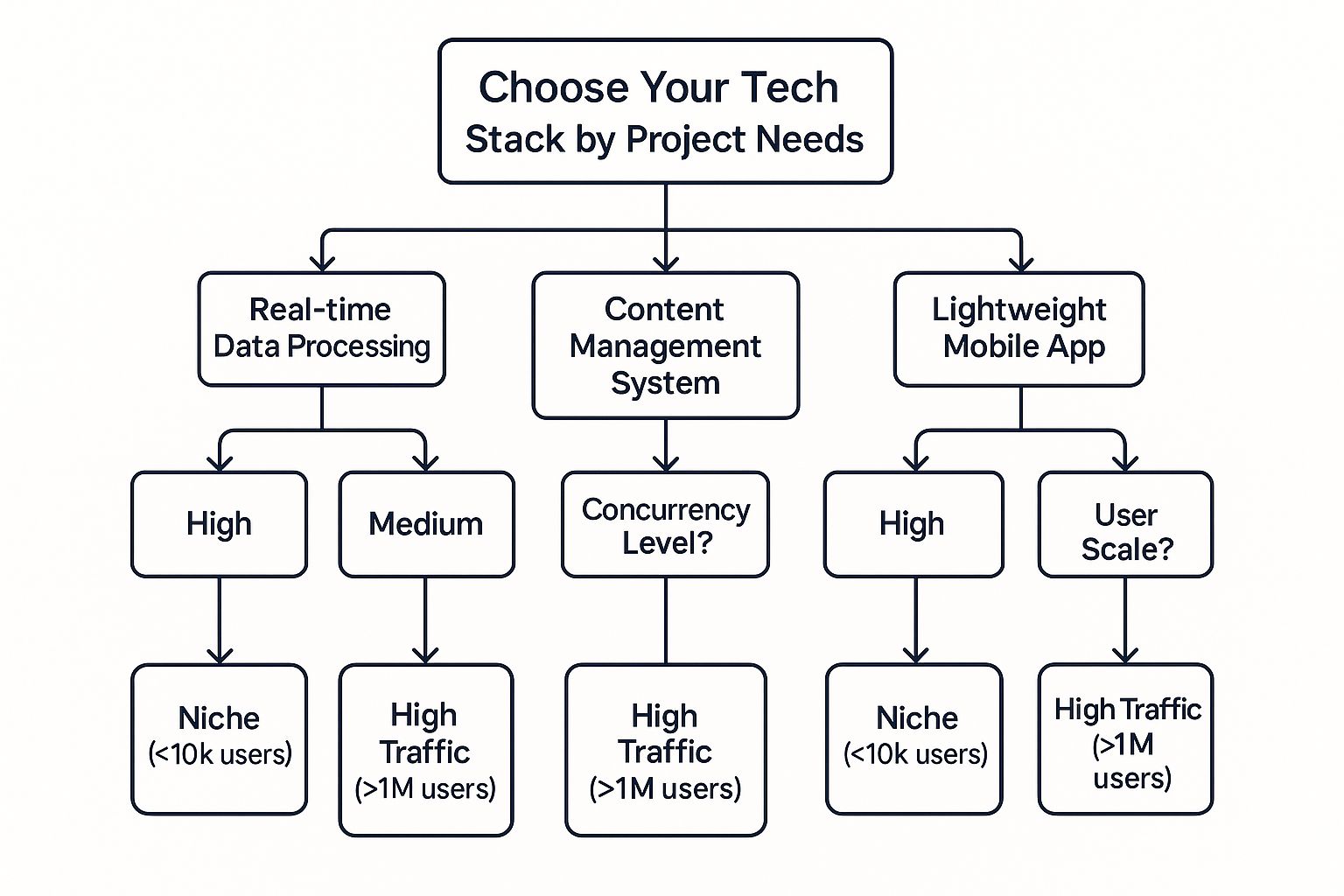
As the graphic shows, there's no single right answer. The optimal path is a direct consequence of your application's core function and expected scale.
Dissecting Your Project's DNA
Let's pause and reflect. To get this right, you need a practical way to break down what your application truly needs to do. Start by asking targeted questions that map directly to technology choices.
The complexity of modern systems means most companies aren't just picking one tool. They're managing a whole suite of them.
In fact, by 2025, organizations will typically manage an average of 5 to 7 specialized data tools within their stacks. A staggering 70% of data leaders admit this complexity is a major headache that slows everything down. But get it right, and the benefits are huge: companies that successfully adopt a modern stack see things like 70% faster query performance and a 50% reduction in total cost of ownership. These aren't small numbers.
The core takeaway is simple: the right stack is the one that solves your specific problems efficiently and can grow with you. It's not about finding the "best" technology, but the "best fit" technology.
For example, if your project is heavily reliant on managing and publishing content, your choice of a Content Management System (CMS) becomes a critical piece of the puzzle. When a CMS is central to your project, it's worth the time to compare various Content Management Systems to make sure your choice aligns with both your strategic goals and your team's workflow.
The following table breaks down how different project requirements directly influence technology stack considerations, helping you map your needs to potential solutions.
Mapping Project Needs to Technology Choices
| Project Requirement | Key Questions to Ask | Potential Stack Implications |
|---|---|---|
| Performance & Speed | Do we need sub second response times? Is this for real time data or a content site? | Affects choice of language (e.g., Go, Rust vs. Python), database (SQL vs. NoSQL), and caching strategy (e.g., Redis, Varnish). |
| Scalability | Will we have 100 users or 1 million? Is traffic spiky or consistent? | Drives decisions on architecture (monolith vs. microservices), database type (relational vs. horizontally scalable), and hosting (cloud services like AWS/GCP vs. dedicated servers). |
| Security | Are we handling sensitive data like PII or financial info? What are the compliance needs (GDPR, HIPAA)? | Influences framework choice (e.g., Django's built in security), authentication methods (OAuth, JWT), and the need for dedicated security tools. |
| Development Speed | How fast do we need to launch an MVP? What is the size and skill set of our team? | Favors frameworks with rich ecosystems and pre built components (e.g., Ruby on Rails, Laravel) or tools that reduce code duplication (e.g., React Native). |
| Ecosystem & Community | How mature is the technology? Is it easy to find developers and documentation? Are there good libraries available? | Established technologies like JavaScript (Node.js, React) and Python (Django) have huge communities, making it easier to hire and solve problems. |
This isn't about premature optimization; it's about making informed choices that prevent you from having to do a painful, expensive rewrite a year down the road because your foundation can't support your ambition. Let the problems you are solving for your users be your north star.
Factor in Your Team's Collective Superpowers
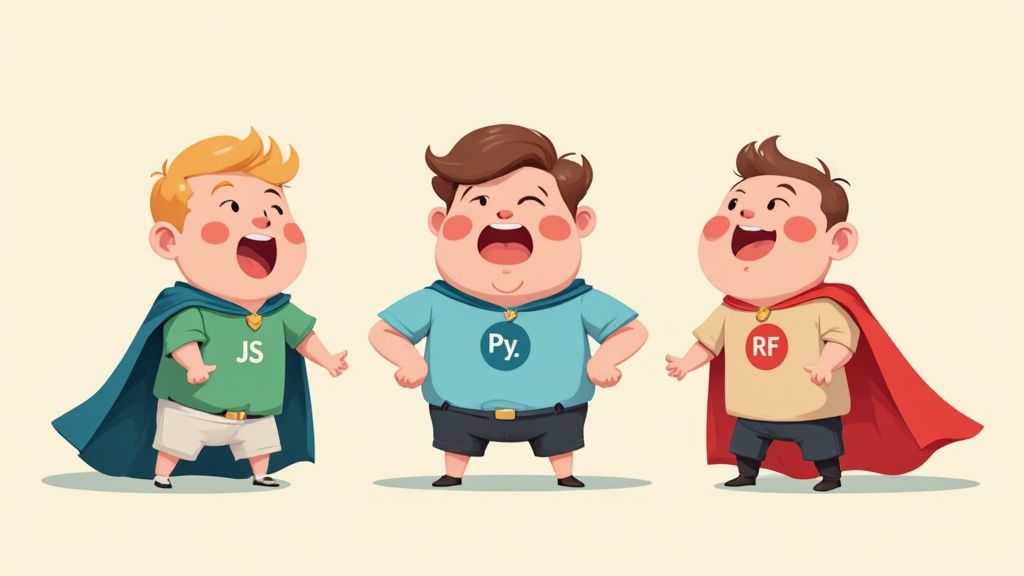
A perfectly designed tech stack is nothing more than a theory without a team that can actually bring it to life. This is where the human element becomes the most important variable in the entire equation. It's a classic balancing act between what's theoretically "best" and what your team can build productively, right now.
Leaning on your team's existing expertise is almost always the fastest way to get your MVP out the door. If your engineers are Python wizards, choosing Django is a no brainer. Forcing them to learn a completely new ecosystem just adds a significant tax to your timeline.
Look Beyond Immediate Skills
But what about the long game? This is where the analysis gets a little more nuanced. You have to start thinking like a strategist, considering not just the team you have today, but the team you'll need to build tomorrow.
Here are a few questions I always ask:
- What's the real learning curve? How long will it take for a new hire—or your current team—to get genuinely proficient in this new framework or language? Be honest.
- How big is the talent pool? Can you actually find and hire developers with this skill set in your city or timezone? A niche technology might be technically brilliant, but if only a handful of people know it, you're just setting yourself up for a hiring nightmare.
- What does the ecosystem look like? Is the documentation any good? Are the forums active? A strong developer community is basically a free, 24/7 support network.
The health of a technology's ecosystem is a massive, often underestimated, factor. I once got stuck on a bug for hours before realizing the library I was using was abandoned. That won't happen with a mainstream tool. A language with a growing community means more libraries, better tools, and faster solutions when you inevitably hit a weird snag at 2 AM.
For example, data from 2025 showed that Python adoption surged by 7 percentage points year over year, its largest single year increase since 2013. The same survey confirmed its expanding ecosystem and usability are driving more teams to build with it. At the same time, AI powered development tools hit mainstream adoption, with 81% of developers using tools like ChatGPT to speed up coding. You can discover more insights about these technology trends at TryTami.com.
The Cautionary Tale of Niche vs. Mainstream
I once consulted for a startup that fell head over heels for a technically "perfect" but very niche functional programming language. On paper, it was beautiful—promising unmatched reliability and mathematical purity.
In reality, it was a slow motion disaster.
Hiring was nearly impossible. When they did find someone, onboarding took months. Simple problems that would be a quick search away in the JavaScript or Python world became multi day research projects. They ended up spending more time fighting the tooling than building features.
A "good enough" mainstream stack that your team can master will always outperform a "perfect" niche stack that your team struggles with. Velocity is a feature, and team proficiency is what creates it.
In stark contrast, another team I worked with chose a very standard stack for their web application. It wasn't the trendiest choice, but their developers knew it inside and out. They were shipping features within days. When they needed to add a new component, a well maintained library was waiting for them. When they hit a snag, someone in the community had already solved it and written a blog post.
If you're building a team from scratch, our guide on getting started with web development can offer foundational insights into these mainstream technologies.
The lesson is crystal clear. The best technology is the one that empowers your team, not the one that looks best in a technical whitepaper. Your team's collective knowledge is your single greatest asset—choose a stack that amplifies it.
Build for Tomorrow's Scale and Budget
Picking a tech stack is a lot like choosing the foundation for a house. You wouldn't pour a simple concrete slab meant for a bungalow and then try to build a skyscraper on top of it. The whole thing would collapse under its own weight.
Your technology choices are the exact same. What feels fast and easy right now might turn into a massive bottleneck later, forcing a painful and expensive rewrite right when your business is taking off. This is the part of the process where you need to put on your long term thinking cap.
Planning for Growth Before It Happens
"Scalability" isn't just a buzzword dropped in investor meetings; it's the real world ability of your system to handle more work without falling over. This growth usually comes in two flavors, and knowing the difference is key to making smart decisions early on.
- Vertical Scaling (Scaling Up): This is like swapping out the engine in your car for a more powerful one. You just upgrade to a bigger server with more CPU, more RAM, more everything. It's simple, but you'll eventually hit a hard limit—you can only buy a server so big, and the costs get crazy expensive, fast.
- Horizontal Scaling (Scaling Out): This is more like adding more cars to your fleet. Instead of making one machine bigger, you add more machines and spread the work across them. This is the foundation of modern cloud architecture and offers way more flexibility, but your application has to be designed for it from the get go.
Most modern, resilient apps are built with horizontal scaling in mind. This means picking technologies and architectural patterns—like microservices or stateless application designs—that are designed to run in a distributed environment.
Understanding the Total Cost of Ownership
The sticker price of any technology is never the whole story. A "free" open source library isn't actually free when you factor in the Total Cost of Ownership (TCO). This is a much smarter way to think about your budget because it includes all the hidden and ongoing costs.
The real cost of any technology is a mix of its licensing fees, the developer hours needed to implement and maintain it, and the infrastructure required to run it. A cheap tool that needs constant hand holding can quickly become your most expensive line item.
Thinking about TCO forces you to ask better questions. How much does it cost to host this thing? How much time will your team spend wrestling with its quirks versus shipping new features? A good first step is creating a realistic software project estimate to see beyond the initial setup costs.
The Hidden Danger of Vendor Lock In
Another long term risk to watch out for is vendor lock in. This is what happens when you become so dependent on a specific provider's proprietary tech that switching to a competitor becomes ridiculously expensive or technically impossible. You're stuck, and the vendor knows it.
This is a common trap with those highly specialized, all in one platforms. They offer amazing convenience upfront but can seriously limit your flexibility down the road.
To sidestep this, try to lean towards technologies built on open standards that have a healthy, multi vendor ecosystem. For example, using a standard database like PostgreSQL gives you the freedom to host it anywhere, from AWS to a private server. That portability is a powerful insurance policy for your business.
The broader economic climate also plays a role here. Industry analysts are forecasting a 9.3% growth in global IT spending in 2025, with software and AI leading the charge. AI spending specifically is expected to grow at a compound annual rate of 29% through 2028. This trend just highlights the need for tech stacks that are not only scalable but also equipped with modern AI, cloud, and cybersecurity capabilities to stay in the game. You can check out a more detailed breakdown of these industry outlooks from Deloitte.
Ultimately, building for tomorrow means making choices today that keep your options open. It's about finding that sweet spot between moving fast now and not painting yourself into a corner later.
Common Traps and Lessons Learned the Hard Way
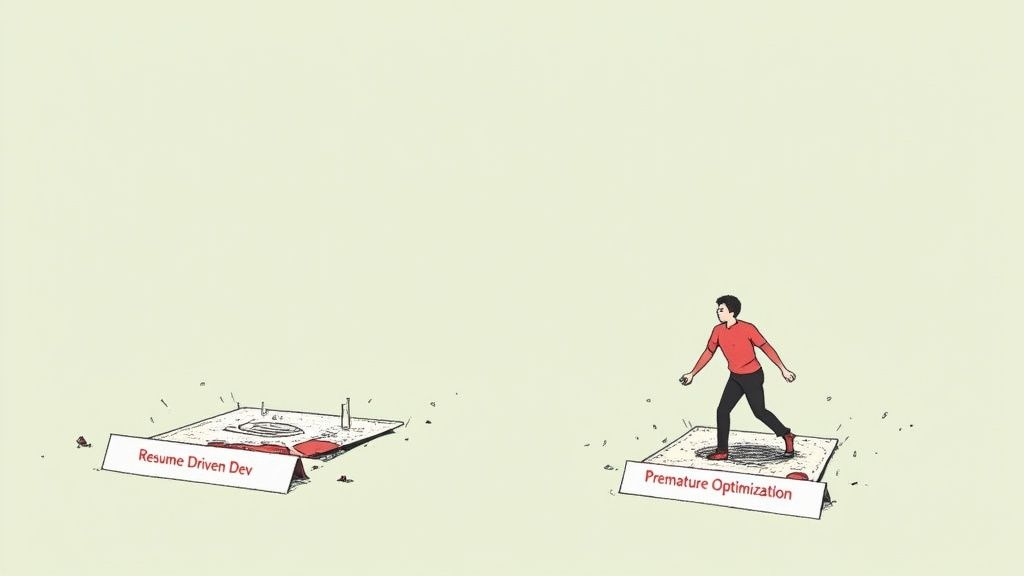
That moment of false confidence before you realize all the tradeoffs.
Learning from your own mistakes is great, but learning from someone else's is far cheaper. And less stressful. Over the years, I've seen teams fall into the same handful of traps when picking a tech stack. They feel like smart moves at the time, but they almost always lead to pain down the road.
This isn't about pointing fingers; we've all been there. Think of this as a field guide to the most common pitfalls—a mental checklist of red flags to watch for as you make your own decisions.
Resume Driven Development
This is the classic blunder. It's when technology choices are influenced more by what an engineer wants to learn than what the project actually needs. It's a subtle but powerful force. A developer might push for a hot new framework not because it's the best fit, but because getting experience with it will look amazing on their LinkedIn profile.
I once watched a small team building a simple internal dashboard decide to use a complex event sourcing architecture with Kafka. It was a fascinating technical challenge, for sure. But it was massive overkill. Development slowed to a crawl as they wrestled with the complexity, and the project eventually had to be simplified after missing its deadline by months.
The lesson is simple but hard to practice: the project's needs must always, always come before personal curiosity. You can build smaller, non critical side projects to explore new tech. Don't let your main product become someone else's science experiment.
Premature Optimization
This trap is perfectly captured by the famous Donald Knuth quote: "Premature optimization is the root of all evil." It's the siren song that convinces you to build for Google's scale when you have exactly zero users.
You spend months designing a complex microservices architecture, setting up a globally distributed database, and fine tuning a caching layer before you've even validated your core idea. All that effort is completely wasted if you build something nobody wants.
A startup I advised spent their first six months building a backend that could theoretically handle millions of concurrent users. But they never shipped an MVP. By the time their funding ran out, they had a beautiful, scalable piece of infrastructure for a product that never saw the light of day. They optimized for a problem they didn't have yet.
Starting with a well structured monolith is almost always the right call. It lets you move fast, iterate quickly, and find product market fit. You can always break it apart later, once you actually have the scale that demands it.
Ignoring the Human Element
The final trap is forgetting that technology is built and maintained by people. You might find a language that's technically superior in every benchmark, but if the talent pool is tiny, the documentation is sparse, and the community is nonexistent, you've just signed up for a world of pain.
Don't forget these critical factors:
- Hiring Difficulty: How hard will it be to find and hire developers who know this stuff?
- Onboarding Speed: How long will it take for a new team member to get up to speed and actually be productive?
- Problem Solving: When you inevitably hit a roadblock, will a Google search yield thousands of solutions, or just digital silence?
The real challenge of how to choose a technology stack is balancing the purely technical with the deeply human. A stack your team can use happily and efficiently will always outperform a technically "perfect" one that causes constant frustration. The goal is to ship a great product, not to win a theoretical debate about frameworks.
Key Takeaways
We've covered a lot of ground. If you remember nothing else, keep these points in mind:
- Start with the Problem: Your project's requirements should be the primary driver of your tech choices. Don't pick a solution before you fully understand the problem.
- Trust Your Team: A "good enough" stack your team already knows is better than a "perfect" one they have to learn from scratch. Optimize for your team's productivity.
- Think Long Term (But Not Too Long): Plan for scale, but don't prematurely optimize. Start simple with a modular monolith and avoid vendor lock in by favoring open standards.
- Beware the Human Traps: Watch out for resume driven development and the allure of shiny new tech. The goal is to ship a valuable product, not build a technical showcase.
- It's an Evolution, Not a Revolution: Your tech stack will change over time. Focus on making smart, incremental improvements rather than chasing the perfect, static ideal.
Got Questions? Let's Talk Specifics
Even with a solid framework, you're going to have questions. This is where the rubber meets the road, and a lot of the decision making is nuanced. It's a field filled with trade offs, and it's totally normal to have some lingering doubts. Let's dig into some of the most common questions I hear from founders and tech leads.
How Often Should We Revisit Our Tech Stack?
Honestly, you should revisit it when you feel pain, not based on a calendar. A full rewrite is almost always a last resort—a massive, expensive undertaking that can sink a startup. Think of your stack as something that evolves, not something you scrap and rebuild.
So, what does "pain" look like? Keep an eye out for these triggers:
- Persistent Performance Bottlenecks: Your app is slowing to a crawl, and the quick fixes aren't cutting it anymore. This is a huge red flag that a core component isn't scaling with you.
- Plummeting Development Velocity: If shipping a simple feature now takes weeks instead of days because of technical debt, your stack is actively fighting your team.
- A Major Business Pivot: When your entire business model changes, the architectural assumptions you made on day one might be completely wrong for your new direction.
The goal here is continuous improvement, not a rip and replace cycle. Focus on upgrading or swapping out individual pieces as they become a problem.
Should I Use a Popular Framework or a Hot New One?
This is the classic battle between a mature, stable ecosystem and the shiny promise of cutting edge features. It's a big decision.
There's a reason frameworks like React or Django are so dominant. They come with massive communities, endless tutorials, and a huge talent pool to hire from. This dramatically lowers your risk and speeds up development. You'll rarely get stuck on a problem that someone else hasn't already solved.
A newer framework might promise better performance or a more elegant developer experience, but it comes with very real costs. The community is smaller, finding experienced developers is a nightmare, and you're far more likely to be the first person to discover a critical bug.
For your core product, the stability and vast support network of a mature framework is almost always the wiser, safer choice. Save the newer, less proven tech for smaller, non critical projects where you can afford to experiment and learn.
What's the Big Deal with "Boring Technology"?
"Boring technology" is a term of endearment for the proven, stable tools that just work. Think PostgreSQL or a battle tested web framework. Their role is to be the reliable, predictable foundation of your application. The last thing you want are surprises when it comes to storing your customer data.
It's tempting to build everything with the latest and greatest tools, but that's a recipe for disaster. Your core business logic and data storage should rely on technologies that are well understood and have a long track record of stability. This approach minimizes unexpected failures and lets you innovate in less critical parts of the stack where the risk is much lower.
Should I Start with a Monolith or Microservices?
For just about every new project, starting with a well structured monolith is the right call. I can't stress this enough.
A monolith is far simpler to build, test, deploy, and manage. That simplicity is your superpower in the early days. It lets you iterate quickly and focus your limited energy on the only thing that matters for an early stage product: finding product market fit.
The operational overhead and complexity of a microservices architecture can easily kill an early stage startup's momentum. Suddenly you're drowning in distributed systems problems like network latency, service discovery, and data consistency before you even have a single paying customer.
The best practice is to design a modular monolith. This means organizing your code within the single application in a clean, decoupled way, almost as if they were separate services. This structure gives you the speed of a monolith today with the option to easily break it apart into true microservices later on, once your business domain is clear and your team is large enough to handle the added complexity. Answering the question of how to choose a technology stack often means picking the simplest path that doesn't close doors to future growth.
Feeling overwhelmed by these choices? As an expert in full stack engineering, Kuldeep Pisda helps startups navigate these exact challenges, building robust, scalable systems with Django, Next.js, and AI. If you need to accelerate your roadmap or strengthen your technical foundations, let's connect at https://kdpisda.in.
Become a subscriber receive the latest updates in your inbox.



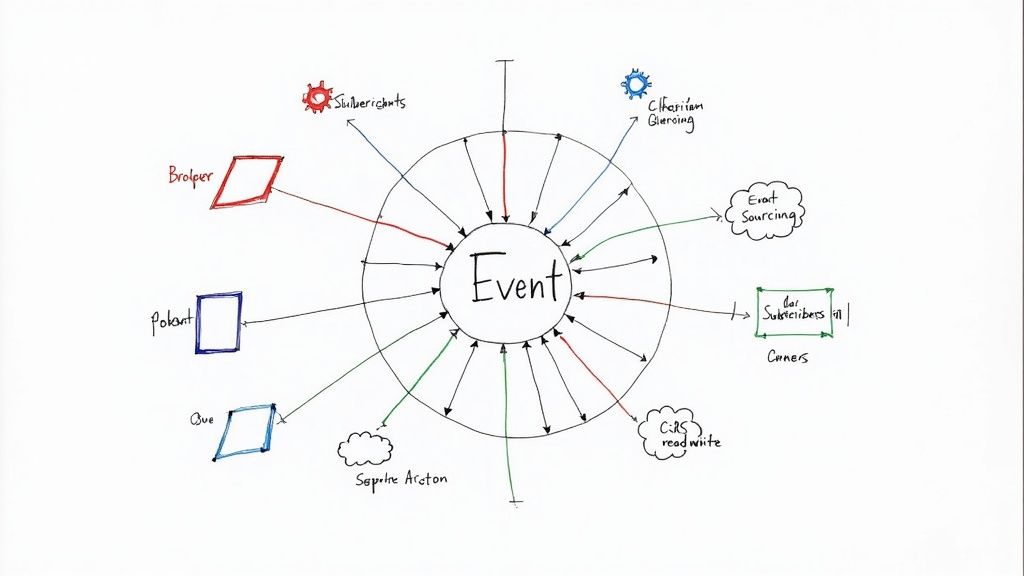
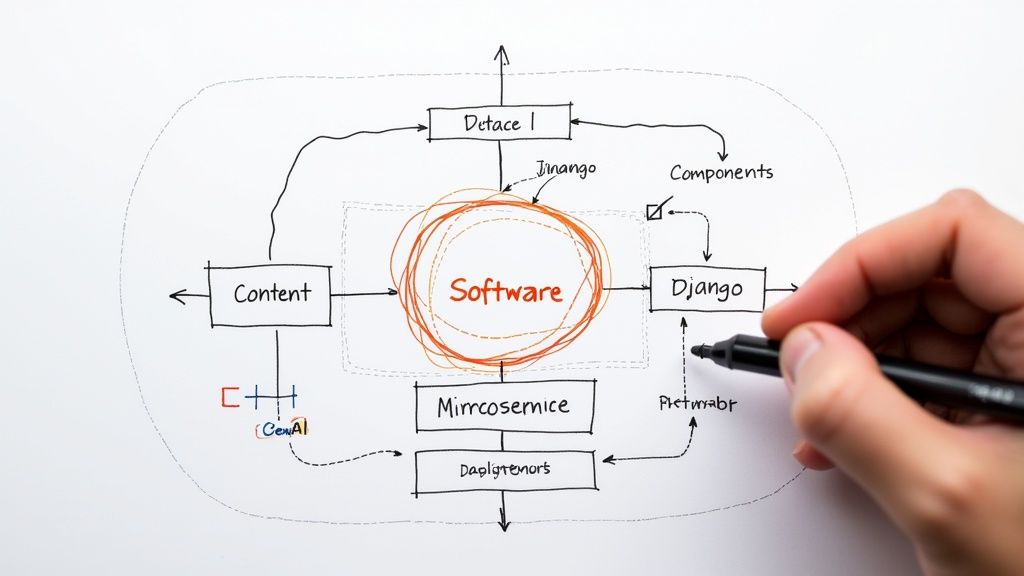
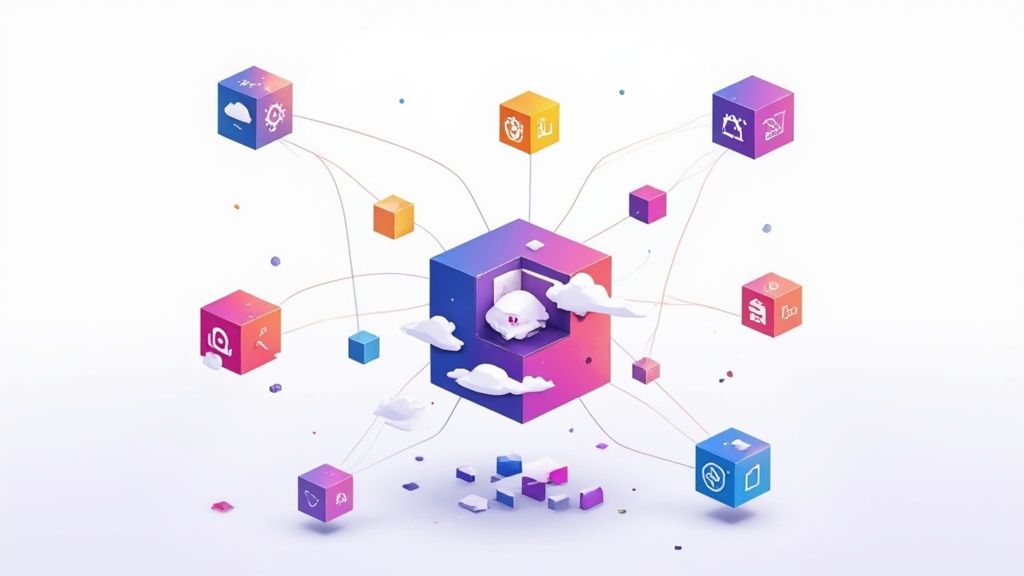
Member discussion